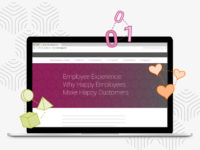Time is a precious commodity, and today’s talent wants to use it efficiently. As a result, traditional training models are being replaced by bite-sized, personalized learning experiences. These on-demand resources are often referred to as microlearning. Microlearning is empowering employees to take ownership of their development, acquire new skills, and contribute more effectively to the organization. Create microlearning opportunities to cultivate top talent from within your company. Follow this guide about developing your talent roster through microlearning and how to implement it into your workforce.
Why Are We In A Microlearning Boom?
Microlearning is the present and future of employee training and leadership development programs. It is a modern instructional design strategy that delivers content in small, specific bursts. This approach caters to the Gen Z population, but even millennials and Gen X are getting on board. That is due to the multigenerational shift in how we all consume content.
Think of how four-minute music videos of yesteryear have been reduced to 15-second TikToks today. With 15-second videos, people can view more music-related content within the traditional four-minute span, thus discovering more songs.
Today’s talent, and certainly tomorrow’s, look at training modules with the same attention span. Traditional employee development videos can run from 20 minutes to a half hour. This content can become tiresome to view, causing employees to miss key points.
According to one study, people prefer to watch content that is between three to six minutes. Microlearning is an effective approach because it accommodates the realities of modern work life, where time is limited and attention spans are shorter. It allows employees the autonomy to manage their time and optimize “little breaks” within their schedules to be more productive.
How Does Microlearning Help Companies?
The importance of training and providing opportunities for growth cannot be overstated. Microlearning allows employees to learn new skills and adapt them to their career paths. It’s beneficial for both the company and the talent.
For companies, it can lead to increased productivity and innovation as employees apply their new skills to their roles. It can also improve employee retention rates, as individuals who feel they are growing and developing are less likely to leave.
Employees also benefit from microlearning, as these opportunities provide a sense of value and achievement. They see that their company is investing in their development, which can boost morale and job satisfaction. Plus, they gain tangible skills that can help them progress in their careers within your company.
What to Consider When Developing Microlearning Materials
To implement microlearning, you first need to consider what type of content you want to provide, what you’re trying to teach, and what you would like your employees to gain from the content they learned.
When developing microlearning materials, there are several key factors to consider that will ensure the success of your training initiative:
- Identify your Audience: The first consideration should be your audience. Understanding who your learners are, their roles, and their learning needs is critical in designing effective microlearning content.
- Set Clear Objectives: Begin with well-defined learning objectives for each module. Clearly articulate what learners are expected to achieve by the end of each session.
- Segregate your Content: Divide your content into need-to-know versus nice-to-know. Include only those content pieces that add value to the learner. This approach helps to keep the content concise and focused on the most important information.
- Keep it Simple and Short: Microlearning modules should be no more than 15 minutes, ideally even less. Choose one learning objective per module and ensure it’s self-contained.
- Provide Variety: To cater to different learning styles and keep the content engaging, provide a variety of content types. This could include videos, quizzes, infographics, or interactive scenarios.
- Include Assessments: Regular assessments help to reinforce learning and provide feedback on learners’ progress. They can also identify areas where further training may be needed.
- Consider Learner’s Environment: When designing effective microlearning modules, it’s important to consider the learner’s environment and prior knowledge. This will ensure the training is relevant and practical. Use communities on Bonfyre to ensure the correct materials are accessible to the intended employees.
By taking these factors into account, you can create a microlearning program that is engaging, effective, and tailored to your employees’ needs. Remember, the goal of microlearning is not just to provide information but to empower employees to use that information to improve their skills and performance.
Microlearning Technology Tools
Microlearning initiatives are only as successful as the tools you use to implement them. Bonfyre is an invaluable resource for ensuring a seamless training and leadership development experience for all employees, regardless if they work in-office or remotely. It integrates with Microsoft Teams, making it easy to incorporate in any work environment.
Bonfyre is an excellent host for your content, creating an organized hub for all training and development materials. It allows you to create communities so only certain materials are available for specific departments or leaders. You can also set reminders for people to complete modules if they are mandatory or may be useful for upcoming initiatives.
Sometimes, employees have trouble prioritizing their development, putting their daily duties first. Help them schedule time for microlearning by creating broadcasts on Bonfyre that encourage all employees to take a half hour to watch a few modules or read training materials. Make it an event so that all employees can do it at the same time, and set up a post-viewing discussion group.
Some employees may even prefer to continue their education off-hours, depending on the workplace operations and procedures. Bonfyre can be accessed anywhere, keeping your content organized and readily available for your talent.
Make Microlearning Accessible to Your Employees
Microlearning is more than just a trend; it’s a powerful tool that can enhance the learning experience, foster employee development, and drive business success. By implementing this strategy in your company, you’re not only investing in your team but also ensuring the long-term success of your organization. Make this initiative easier to implement in your work environment by using Bonfyre. Bonfyre allows you to communicate with employees, receive their feedback, and host content all in one place!









